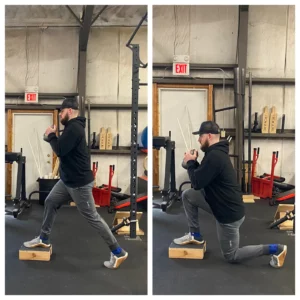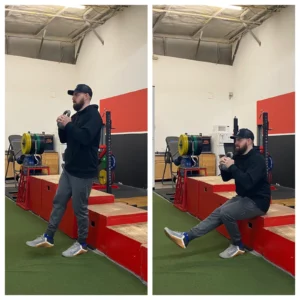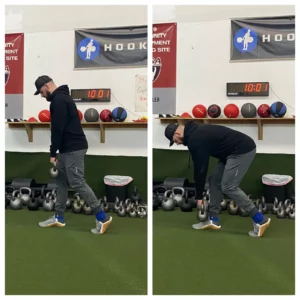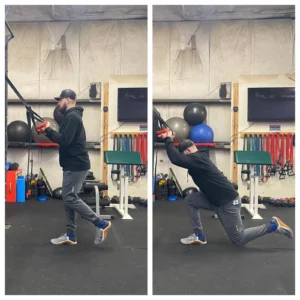The Best Single Leg Exercises For Runners
by Andrew Merritt, CSCS
Earlier this year, Dr. Connor Bombaci of Barbell Therapy & Performance wrote a blog on the benefits of single leg training, and how it is often underutilized in most training programs (check it out here if you haven’t yet). In his blog, Connor talked about the benefits of single leg training for strength athletes, and rehab patients improving their ability to get up and down from the floor. Another population of fitness enthusiasts and competitive athletes that can see improved results from spending more time on one leg is runners.
Running is a single leg activity. Whether you’re out for a light jog, trying to beat your best 5k time, running a marathon, or chasing your dog down the block, you have to be able to absorb impact, adapt to changing terrains, and produce force all on one foot. Single leg training will prepare you for these demands by strengthening the muscles and connective tissues that absorb the impact of each step and propel you forward; improving balance and stability; building work capacity in your legs without taxing your entire body; and improving your running economy so you can run more efficiently. Now that we’ve covered why single leg training can improve your running performance, let’s talk about some of our favorite single leg exercises here at Arkitect Fitness.
Split Squat
Split squats are a great place to start with single leg training. Essentially a stationary lunge, the split squat is a split pelvis (staggered stance) exercise that targets the quadriceps, hamstrings, glutes and calves, all of which are major muscles when it comes to running. To set up for a split squat, start in a staggered stance and slowly lower your back knee to the floor, keeping your torso upright as you go down. Make sure your stride is long enough so your front knee is stacked over your front ankle, and your back hip is directly over your back knee. Push through your front foot and extend your legs to return to the starting position.
This is a great exercise to start with because having your back foot on the floor minimizes the balance requirements and allows you to fully target the muscles of the front leg while still improving your stability.

Bulgarian (Rear Foot Elevated) Split Squat
The Bulgarian split squat is very similar to the regular split squat, except instead of putting your back foot on the floor, you will elevate it either on a box or bench, or a rack roller if you are fortunate enough to have access to one. Elevating the rear foot will cause your center of gravity to shift forward, which will lead to your hips hinging backwards as you bend your front leg and lower yourself down.
The added hip hinge in the RFE split squat will put more emphasis on the hamstrings and glutes that a standard split squat does not. You can also alter how quad dominant the RFE split squat is by moving your front leg farther away (less quad dominant) from or closer to (more quad dominant) the elevated rear leg. Elevating the rear leg also removes the added stability of both legs on the floor in a split squat, making this exercise a good way to develop your balance as well.

Front Foot Elevated Split Squat
The front foot elevated split squat is set up very similar to the standard split squat we discussed first, however you will elevate your front foot 1-3 inches by standing on a plate or small box. The FFE split squat targets the same muscles as the split squats listed above, but the added elevation of the front foot increases the range of motion your hips go through, allowing you to stretch and strengthen them more effectively. The added range of motion will benefit your quadriceps as well.

Single Leg Squat
Much like the three split squat variations we’ve already discussed, the single leg squat (sometimes called a pistol squat) trains the quadriceps, hamstrings and glutes. However, compared to the split squat and its derivatives, the single leg squat requires a higher degree of balance, mobility, and stability. The single leg squat is performed standing on one leg with your other leg held out in front of you as you descend into the squat. Given the mobility requirements of the hips and ankles, and the stability needed at the knee, we recommend doing the single leg squat onto a box, bench or chair. You can adjust the height of whatever you are squatting on to as you increase proficiency.

Lateral Step Up
Many runners, especially if they don’t do any strength training, get stuck in the habit of only training forwards and backwards, neglecting side to side lateral movement in the process. That’s why one of our favorite exercises for runners is a lateral step up. For this exercise, stand perpendicular to a box, holding a weight in front of your chest or on your side opposite of the box. With your inside foot, step up onto the box and drive upwards, fully extending your knee, driving your outside knee upwards at the same time. Slowly lower yourself down and repeat.
The lateral step up works the quadriceps, adductors, and glutes, which are all vital for running performance; especially the latter two, which help keep your weight centered over whichever is on the ground with each stride.These also promote knee and hip stability, which will improve your performance and prevent injury.

Lateral Lunge
The lateral lunge has many of the same benefits of the lateral step up, training the quadriceps, glutes and adductors. To perform this exercise, start standing with your feet together. Take a big step to one side, and shift your body weight towards the foot you just stepped with, bending your knee as you shift. Go as low as you are comfortable with (remember you are a runner, not a dancer), driving through your foot and stepping back to the starting position. You can either do all reps on one side first, or alternate sides with each rep. Like the lateral step up, this is another great exercise for runners since it trains important muscles for running, as well as improves your ability to balance your weight on one foot.

Split Stance Deadlift
Like the split squats we talked about earlier, the split stance deadlift is another split pelvis exercise completed with a staggered stance. Start by standing with your feet directly under your hips, then take a small step backward so your feet are 3-6 inches apart, with your front foot flat and your back on the balls of your feet. There are a lot of ways you can add weight to this exercise, but we recommend holding a kettlebell or dumbbell on the same side as your back foot. Once you have your feet set, softly unlock your knees and hinge your hips (think about pushing them back towards a wall behind you), reaching the weight in your hand towards your front foot. Once you’ve hinged back as far as you can, return to the starting position by extending your hips and standing up tall.
The split stance deadlift is a great exercise to strengthen your posterior chain (hamstrings, glutes and calves), which help propel you forward by extending your hips and flexing your knees, as well as helping you slow down and change directions while running.

Single Leg Deadlift
Once you’ve mastered the split stance deadlift, you can move on to the single leg deadlift. This exercise trains the posterior chain as well, but your back foot is off the floor the entire time, meaning you’ll need more balance and stability to perform it. Performing single leg deadlifts will not only strengthen your hamstrings and glutes, but also all the stabilizing muscles in your core, hips, knees, and ankle; which will help prevent injuries while you’re out running.

Skater Squat
The skater squat is a phenomenal single leg exercise because much like a trap bar deadlift, it meshes both squat and hinge patterns, effectively training the major muscles of your hips and legs at the same time. The mobility and stability requirements are similar to the single leg squat and deadlift, making this a great exercise for all runners. You can start by holding rings or TRX ropes for added balance, and place a pad or small box behind you to control your depth and ensure you don’t go past your comfort level. These can be removed as you progress, eventually holding weights in front of you as you squat down.
To be a successful runner, your training needs to include more than just running. Runners can see a number of benefits, for performance and overall health, from regular strength training in general, but to meet the physical demands of running, and get the best results on race day, single leg exercises should be a main feature of any runner’s training. Whether you are a daily runner, a weekend warrior, or have a big race coming up, these are all exercises that should be included in your workouts to improve your performance.




